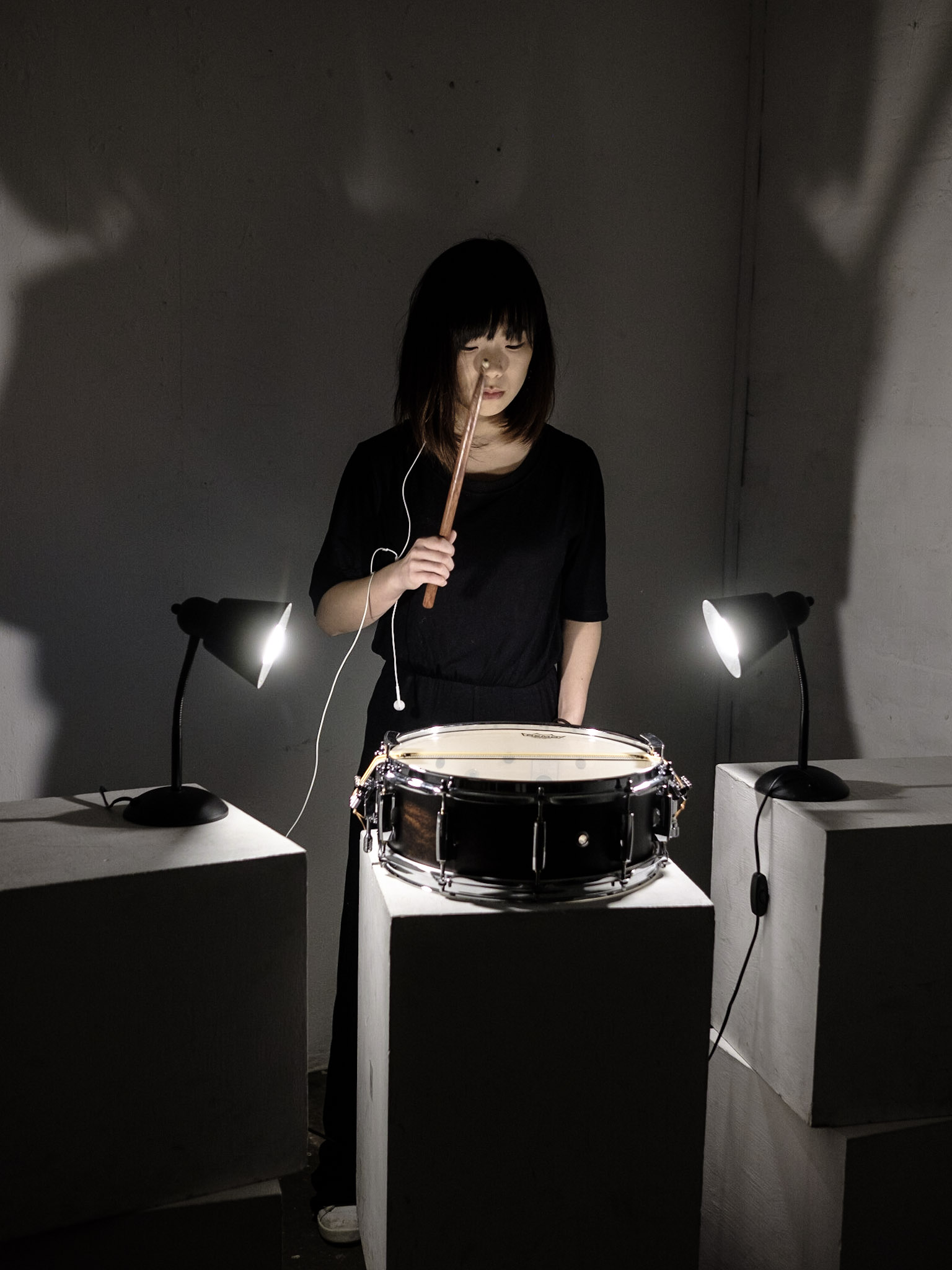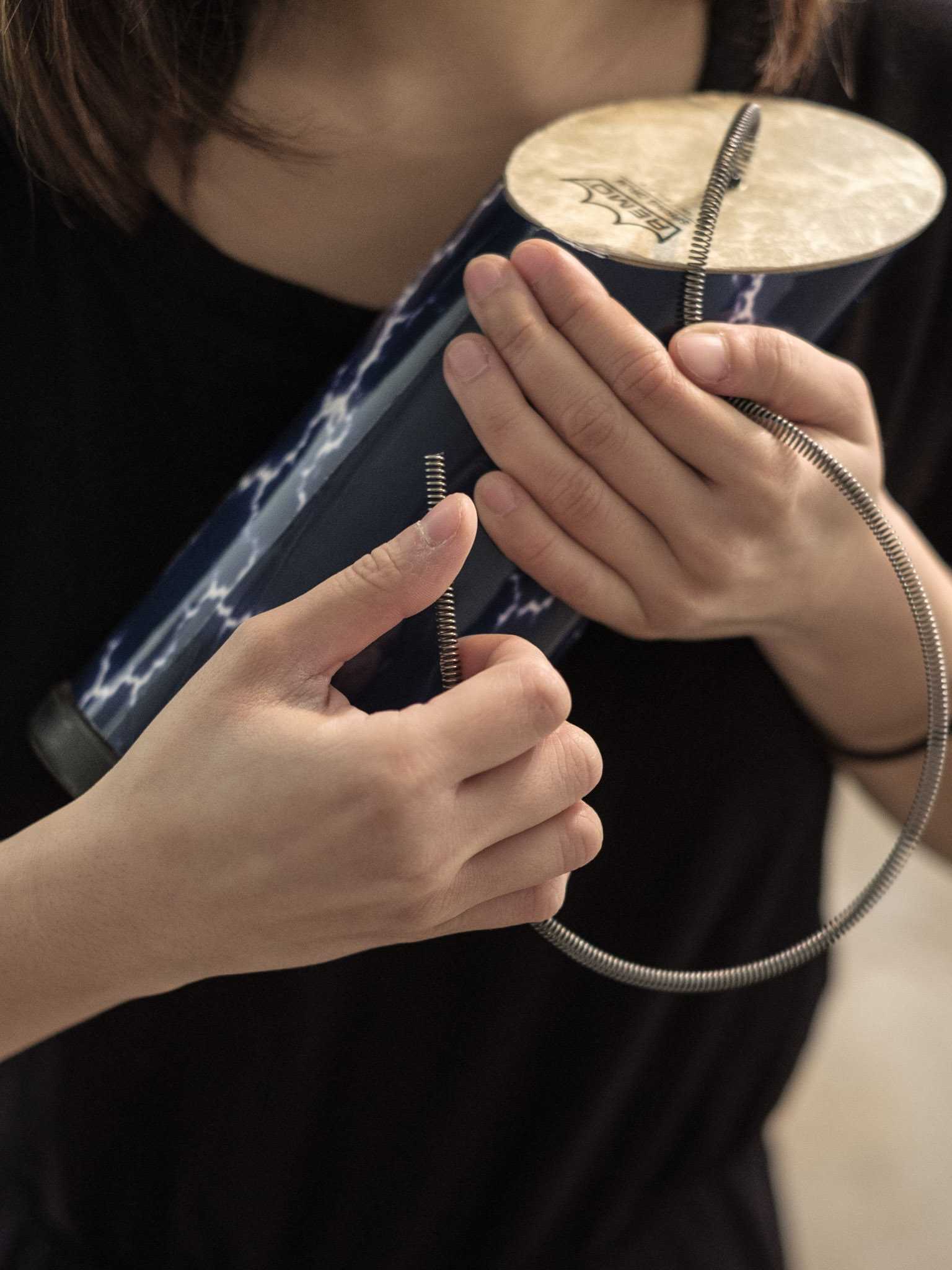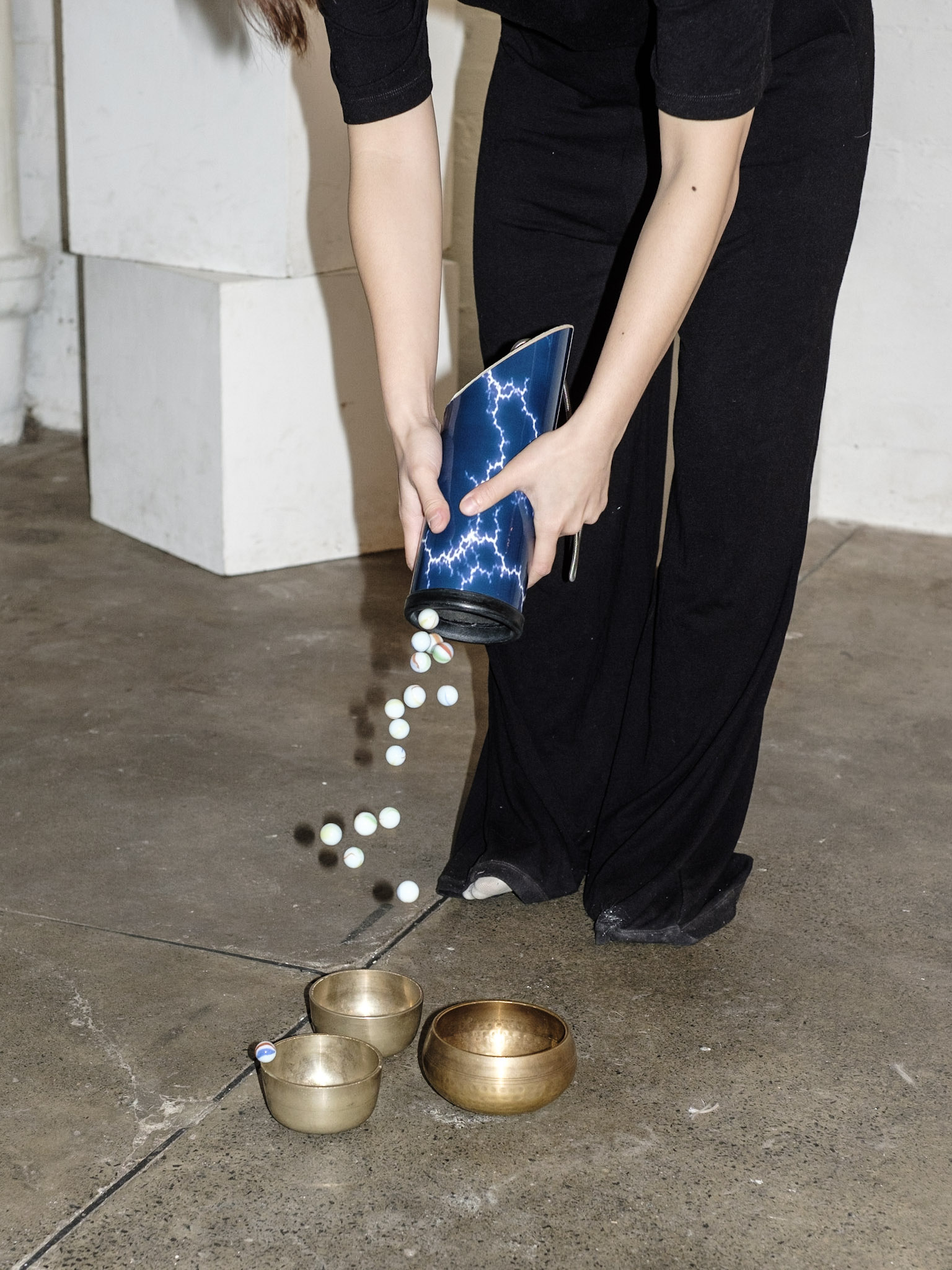Rice on a glockenspiel: an odyssey into new percussion with Angela Wai-Nok Hui

Photo: Dimitri Djuric
Profile of Percussionist Angela Wai-Nok Hui
The first time I see her, percussionist Angela Wai-Nok Hui cuts an arresting figure. She’s standing in the dark against a black background in the foyer of the Queen Elizabeth Hall in London. As she hits a snare drum, lights spark from the side of the kit, briefly illuminating the space, adding a visual texture to the sound.
Half way through, a few bars of I’ll Make Love to You by Boyz II Men blare out through the speakers.
The audience looks around, some look irritated, wondering who’s accidentally broadcasting Absolute 90s R’n’B Radio across the performance. But it’s part of the piece and Angela is magically drumming perfectly in time with the beat.
Bilious guts, porny donuts?
Angela’s playing Commitment :: Ritual I ::BiiM for snare drum, lights and electronics by Jessie Marino. Marino’s a composer / performer / media artist from Long Island, New York who’s known for her experimental works. Her works have wonderfully esoteric titles and instrumentation:
- Odd Bilious Guts (and Porny Donuts) for Human Tuba and Midi Tuba
- Endless Shrimp for two performers, kitchen instruments, and video.
- Pleasure Dairy – performance installation for vibrating bed, ceramic nipples and video.
- Vivaldee for cello, piano and fake blood.
- The Portal for two performers, orchid and video.
Angela is performing as a prelude to a concert by the London City Orchestra. After the Marino piece, she plays Aphasia for body and electronics by Mark Applebaum, and follows the concert with two pieces for marimba – the Andante from J S Bach’s Violin Sonata No.2 and Indifference by Joseph Colombo.
Angela plays ‘Aphasia’ by Mark Applebaum in a tunnel
This eclectic programme is indicative of the diverse style that Angela finds herself drawn to.
“I’m fascinated by making different sounds and I really like theatrical performances, holding the atmosphere and the space,” she says.
The harp in the percussion section
This is all new to me. I’ve played classical music in orchestras for years and the harp comes under the percussion section so there’s a sense of fellow feeling there.
I disappeared down a Googlehole trying to find the reason why the harp is percussion. You can use it percussively, by knocking your knuckles or tapping your fingertips on the wooden soundboard, or giving a section of strings a ‘dead slap’ by hitting them with an open palm. But, for the most part, we pluck the strings. So logically, the harp should be part of the string section.
In any case, I like percussionists. Like me, they have to deal with unwieldly instruments. While I’m trying to squeeze the harp into a service lift, they’re bowling timpani through labyrinthine backstage corridors. Like me, they’re among the first to arrive and last to leave any rehearsal, and we often find ourselves in the street outside after a concert, waiting for our Addison Lees together.
And while I’m familiar with the regular percussion instruments and the usual ways of playing them, Angela’s approach was something different. That’s why I wanted to find out more about her experiences and what inspires her.
From Hong Kong to the QEH
Angela has had a long and interesting musical journey since she left her family home in the Tai Po district of Hong Kong. Having moved to a school in Burgess Hill at the age of 13, she went on to study at Chetham’s School of Music in Manchester and the Royal College of Music in London.
She was a percussion finalist in the BBC Young Musician of the Year in 2010 and has subsequently taken part in a variety of contemporary music festivals across Europe.
Making percussion out of household rubbish
Percussion was always her first love, she tells me, sitting in a café in Notting Hill after spending some time in the studio. “In Hong Kong, children usually start by learning piano or strings. But I hated the piano and found it really hard. I kept asking my mum if I could play drums instead and she always said no.”
“So I started making percussion instruments from bits of rubbish I found around the house. I’d put rice in a pot and put paper on top to make it into a drum or shaker. Eventually, when I was 13, my mum gave in and found me a drum teacher.”
“I kept asking my mum if I could play drums and she said no. So I started making percussion instruments from bits of rubbish I found around the house. Eventually, she gave in.”
“He was called Jeremy Chan and he was such a great teacher – a lot of fun and very inspiring. He taught me tuned percussion including timpani and the xylophone, and took me to perform with him.”
Angela playing Avner Dorman’s ‘Percussion Concerto: Spices, Perfumes, Toxins!’ with the Hong Kong Young Musicians’ Wind Orchestra in 2016
During that time, Angela honed her orchestral skills by playing with a youth wind band, the Hong Kong Young Musicians’ Wind Orchestra.
Sadly, Angela lost touch with Jeremy after leaving Hong Kong and hoped that he might track her down when she went back there to play the Avner Dorman percussion concerto three years ago.
“There were posters out there with my picture on and I really hoped he’d see one and come along, but he didn’t. I’m gutted he’s not in my life any more.”
Next stop, Burgess Hill
When Angela was 14, she left Hong Kong and went to boarding school in Burgess Hill. Wasn’t that a huge culture shock, going from the monasteries, mountains and butterfly sanctuaries of Tai Po to a West Sussex commuter town?
“I was very homesick for the first two years,” says Angela. “My sister was already at school in Dorset, but I only saw her on occasional weekends.”
“The strangest thing for me was getting used to boarding school routine – having prep time after dinner, house meetings, putting my name tag on all my clothes and having a lights out time. That was all so different from when I was living in Hong Kong with my parents.”
Young Musician of the Year on the radar
Angela got her Grade 8 in percussion and played in the school orchestra, but admits that: “I didn’t practise very hard. I wasn’t even thinking about being a musician at the time, I was just having fun.”
Until one night in 2008 she was in the school common room and started watching the final of the BBC Young Musician of the Year. “Jim Molyneux was playing Michael Torke’s Rapture – Concerto for Percussion and Orchestra and I was blown away. I thought, that’s so cool. I want to play like that,” she says.
“When I saw that he studied at Chetham’s, I decided to go there. My sister came with me to the audition, where I played my Grade 8 marimba piece for Paul Patrick, Principal Percussionist at the BBC Philharmonic. I got in and felt really welcomed there.”
“Boom in your face” – a change of pace
But the pace of work came as a shock. “It was boom in your face,” says Angela. “Everyone was practising non-stop and preparing for competitions. We had to wake up early and do aural lessons, practise, go to choir, do ear training. It was really hard! I was also really shy and timid back then.”
Gradually, things improved and Angela got used to the demands of life at music college. In 2010, when she was in the Upper Sixth at Chetham’s, she entered the Young Musician of the Year competition and was delighted to get through to the percussion category final, where she played: Pezzo da Concerto No.1 by Živkovic, Land by Muramatsu, Sous L’aile Du Vent by Pécou and Scherzo by Ptaszynska.
“I didn’t know I was supposed to be scared.”
Watch Angela play the Ptaszynska Scherzo and she looks totally assured, no hint of nerves.
“I didn’t feel any fear because I didn’t know I was supposed to be scared,” says Angela. “No one had told me it should be nerve-wracking. I really enjoyed my time on stage surrounded by cameras.”
“But it would be different now. There’s a Cantonese saying that the newborn calf isn’t afraid of the tiger. I was like that. I didn’t know what to expect, so I just played and enjoyed myself.”
The Royal College and a new discovery
From Chetham’s, Angela moved to London to study at the Royal College of Music, where she also studied her Masters. “I had some amazing teachers and mentors there,” she says, “particularly David Hockings, head of percussion, and Alex Neal, my professor of percussion.”
“It was at the Royal College that I really discovered contemporary music,” she says. “The piece that drew me in was a body percussion piece by Vinko Globokar called Corporel. The performer has to make lots of weird noises, clicking and tapping on their head, ending up shouting and singing.”

Spring drum: sounds like a giant metal centipede / distant thunder. Pic: Dimitri Djuric
“It’s meant to be for a topless male performer, but I wore a skin-coloured top and trousers. Your brain is really intense after you perform it. I can still remember the feeling – my heart was beating so fast. You just have to go completely nuts.”
Since then, Angela has pursued her interest in contemporary music all over Europe. She’s worked with composers and ensembles and has participated in Sonorities Festival of Contemporary Music in Belfast, Darmstadt Ferienkurse für Neue Musik in Germany, Linea Ensemble Academy for contemporary music in Strasbourg and Huddersfield Contemporary Music Festival.
Rice on a glockenspiel – searching for new sounds
“Darmstadt was mind-blowing,” she says. “I was there for three weeks and met a lot of composers and new music percussionists from Europe. I thought I already had a good insight into percussion, but I hadn’t experienced anything like that during six years of music training.”
“People were putting rice on a glockenspiel, hitting a bass drum with a toothbrush, pouring milk onto fish and vegetables, playing percussion with dildos and vibrators. Just listening to very odd stuff with a straight face. I loved that everyone was looking to find a new sound.”
‘Fury II’ for double bass and ensemble by Rebecca Saunders, one of Angela’s favourite composers
“It was similar at the Impuls festival for Contemporary Music in Graz. I played in a piece by Michael Maierhof where six performers each had two motors, empty plastic cups and a bucket. The composer was so disciplined in the sound he wanted to create, telling us exactly where to find the sweet spot on the bucket.”
Marbles and a giant centipede
Another high point in Graz was collaborating with Chinese composer Zhuosheng Jin on a new work called Pale Flower 1.
“It was so interesting to work with Zhuosheng,” she says. “He’s such a perfectionist about everything from the sound to the lighting. Everything has to be sooooo precise. I was so relieved after the last performance of Pale Flower 1 when he said to me, “It was great. You have convinced me about the timing and all the choices you made. It was almost perfect.”
Angela plays the world premiere of ‘Pale Flower 1’ by Zhuosheng Jin at the 2019 Impuls Festival in Graz, Austria
In this work, Angela is in the dark and you hear small, spattering, clicking noises, like the sound of a giant metal centipede crawling across a typewriter. As a sliver of light appears, we see her standing by a mirror and realise it’s not a centipede, it’s a spring drum. (This is a small tube drum with a metal spiral that springs out from one end. As well as metal centipede noises, it makes the sound of distant thunder. Every home should have one.)

Angela tips marbles onto brass Tibetan bowls in Pale Flower 1 by Zhuosheng Jin. Pic: Dimitri Djuric
Angela tickles marbles in a small brass Tibetan bowl, then drops them one by one inside the drum. She whispers into the drum. (It’s a secret phrase, we’re not allowed to know what she’s saying.) Barefoot, she walks over towards three larger Tibetan bowls on the floor and shakes the storm drum above them. Finally, she gives the drum one last violent shake and all the marbles fall out, singing as they hit the metal bowls and we hear them scattering across the wooden floor.
She sits down, cross-legged, the lights go out and we’re back in darkness.
A new commission
Having worked with Zhuosheng Jin to create Pale Flower 1 together, it was a natural next step for Angela to commission some new work.
“I’m currently talking to composers in Hong Kong, the UK and mainland Europe about a work that will explore my sense of identity. It will be a series of 13 short pieces each lasting around 3-5 minutes.”
One of the composers is Dani Howard, a British composer who grew up in Hong Kong, so shares a UK / Hong Kong axis with Angela.
“We’re still talking about the concept,” says Angela, “but I’m thinking of having two different percussion sets on stage, representing two completely different ideas. Through collaboration, myself and all the composers will explore the idea of ‘identity’. The two sets of instruments could mean different things/ situations/ problems for everyone involved in this project. I also think there should be some plants on stage – maybe a cactus and a tree? We shall see!”
One to watch
This has been a fascinating voyage into the world of contemporary percussion music. Next time you see someone tickling marbles in a Tibetan brass bowl or throwing apples in a forest, you might wonder if it’s a percussion performance. And if Angela’s involved, you really should stop and listen.